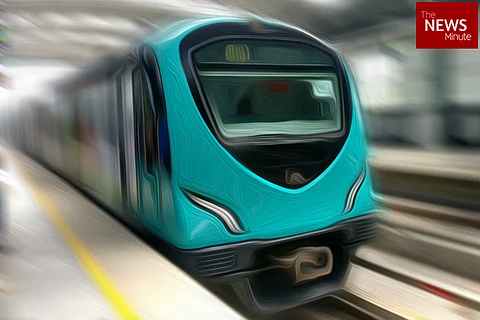

In a city with a substantial population, which sees hundreds of thousands of tourists, the Kochi metro was supposed to connect 8 lakh people in the city’s business centre. With promises of cheaper and efficient travel in this busy segment, the one-year report card of the first phase between Aluva and Palarivattom, does not bode well for the last mile connectivity that it promised.
Inaugurated by Prime Minister Narendra Modi on June 17, 2017, this 13-kilometre stretch sees the footfall of an average of 40,000 passengers a day. However, the list of woes that commuters face in terms of accessing the metro and their final destinations from it, runs long.
For one, residents say the metro hasn’t really done much to reduce the congestion seen on the roads. MV Varghese, a businessman who gave up the land he owned at Jose Junction for the metro, says that the metro doesn’t connect all those many people as it claims.
“It still doesn’t connect areas like Palluruthy, Vaduthala, Chittur and Mattancherry, the most crowded parts of the city. And it doesn’t travel to places like High Court, Revenue Tower and Marine Drive, which sees the maximum footfall,” he points out.
According to him, one good thing that came out of the metro is that the roads near the lines were widened, which has eased traffic a little in those areas.
Poor connectivity
Abhijith Muraleedharan, a research scholar at Cochin University of Science and Technology says that the biggest drawback of the metro service is the lack of feeder services.
Every day, Abhijith travels from the Jawaharlal Nehru Metro Station to the Maharaja’s Station. From his house, he walks to the metro station, and then from his stop to his destination.
“But on days I am in a hurry, I can’t walk. I have to then take an auto, which then becomes expensive. An affordable feeder service is a must. In Delhi, for instance, there is a network of shared autos to take you from your house to the closest metro station, and then from the metro station to your destination,” he says.
The Kochi Metro Rail Limited intends to set up a feeder service, making use of the existing network of vehicles like private buses and shared autos. This way, it isn’t adding to the chaos and pollution seen on the Kochi roads.
An integrated service
Officials in KMRL say that 15,000 shared autos will be part of the new service, which will be ready in three months. The autos will reportedly be painted a different colour, and the drivers will sport a different uniform.
Metro passengers, officials say, will only need to pay Rs 7 for the first two kilometres of the journey, and three people can share a single auto.
“We are in the final stage of discussion, and nine trade unions affiliated to different political parties have been included in the service. We have been trying to convince the autos to come under one roof for three years, and we finally succeeded,” KMRL spokesperson Reshmi CR told TNM.
Private buses have also been drafted into the service, and seven private companies will be operating services soon. The buses will be installed with GPS, which 700 buses have already been fitted with. The GPS will be integrated with KMRL’s ‘Kochi 1’ app, so commuters can track their buses and trains. Officials also say that the metro card can soon be used in the buses too.
“When the Unified Metropolitan Authority, that aims to integrate bus, train and boat services, comes into existence, things will be easier. We will then get the freedom to create a uniform timetable for the buses and metro trains,” Reshmi added.
Is it cost effective?
Currently, the lowest fares cost between Rs 10 and Rs 50. For commuters with cards, the fare ranges between Rs 8 and Rs 40.
Says Abhijith, “The fare one way for me is almost that of an AC low-floor bus. Before the metro came here, I used to take my two-wheeler to campus every day. After calculating the costs, I have realised that the cost of putting petrol in my two-wheeler and travelling to my campus, and taking the metro is almost the same. The government must reduce the rates.”
Earlier, residents had complained that the parking charges were too high in the metro stations. Many residents brought their own vehicles to the stations, and then used the metro. However, the high parking charges acted as a deterrent.
Listening to the complaints, and in a bid to encourage more people to use the metro, the rates were slashed. The rates for the first two hours is now Rs 25 for four-wheelers, and Rs 10-15 for two-wheelers. After this, every hour Rs 10 is charged for cars, and Rs 5 for bikes.
A daily parking pass is available in all stations, except Aluva and Edappally.
In a bid to encourage more people to travel in the metro, KMRL waived parking fees in the summers in all stations, except Aluva and Edappally. This initiative is likely to be extended during Onam days as well.
Change on the cards
Sankara Narayanan, the Director of Qurobit Consultancy Services, which consults for the Kochi Metro, says that the impact of a public transport system can only be assessed in the long run.
“The effect of a public transport system can only be assessed when the utility is higher, when the service is upgraded as in the other cases of public transport of the cosmopolitan cities. At this phase, we can’t say that all the public transport flow has been converted to the metro. Also, we haven’t achieved the full alignment as we had conceived the project,” he admits.
According to him, a comprehensive plan has been drawn up, with feeder services, to connect boats, buses and metros. However, it’s too early to judge the metro, he says. Especially considering it’s not reached peak utility.